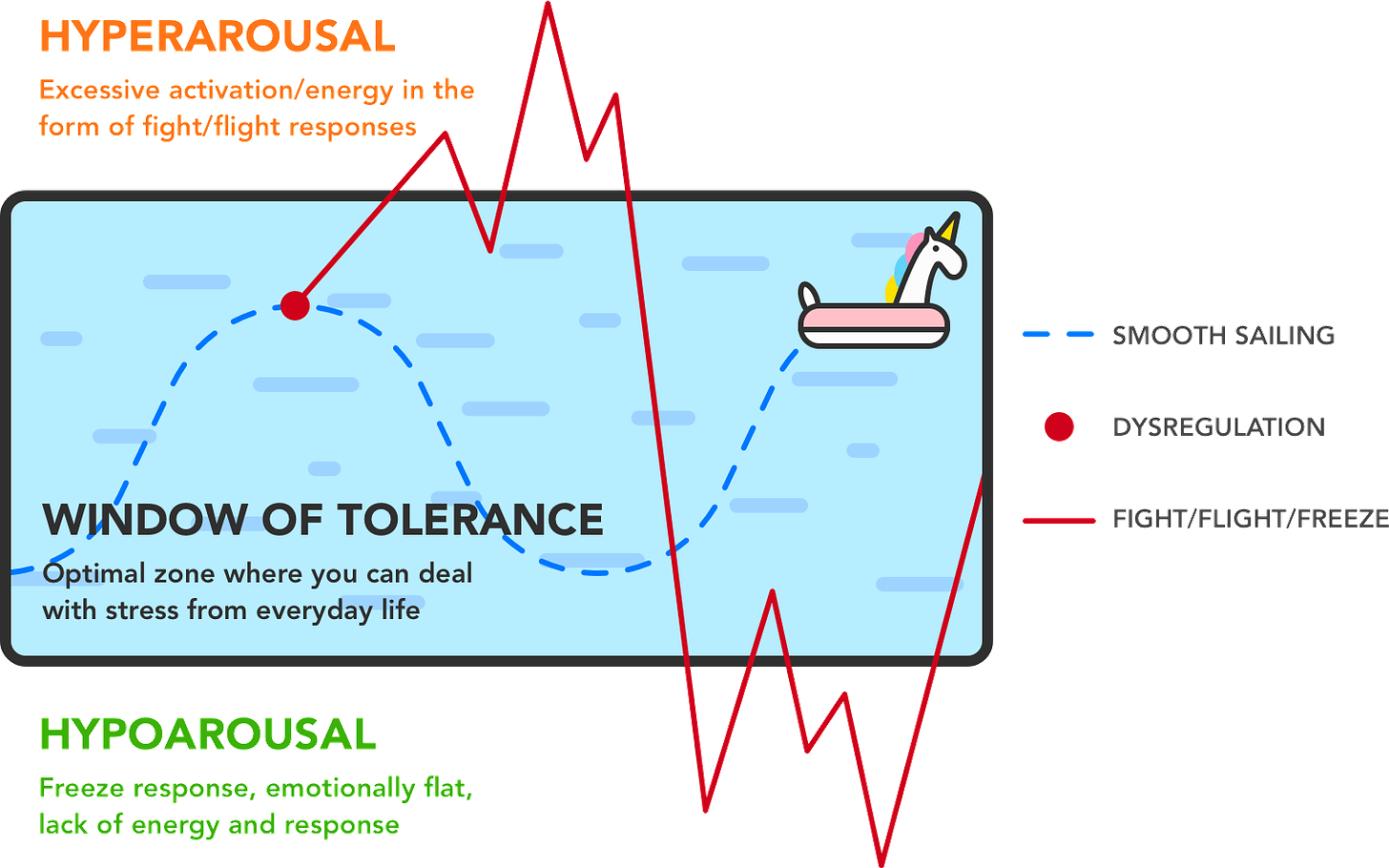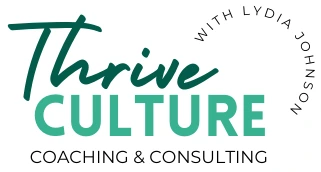Currently, three men are cutting giant holes in my house to enlarge several windows (for both aesthetics and because our bedrooms aren’t actually bedrooms due to lack of egress/exit windows).
This project has been three years in the making between COVID supply chain issues and contractor woes. It’s been a real struggle… let’s not talk about it.
We SHOULD talk about your windows, though.

No, not your house windows, as pretty as they may be.
Your window of stress tolerance. A concept created by Dr. Dan Siegal to describe the ‘optimal arousal zone’ of human beings.
Research shows that each of us has an optimal window of tolerance.
When we’re operating within our window, we’re able to roll with the punches. We can handle the stressors life throws at us with ease and grace.
When we’re outside our window of tolerance… bad stuff happens. Anger, stress, overwhelm, and poor coping mechanisms. Basically, the horsemen of the apocalypse.
There are two types of dysregulation you can experience when you’re outside your window: Hyperarousal and hypo-arousal.

If we’re hyperaroused, then our flight or fight instincts have kicked in. We’ll likely feel anxious, overwhelmed, emotional, impulsive, self-critical, and stressed.
This is when you snap at your kids, rage apply to jobs after a stressful meeting, impulsively stress-eat ice cream, or crave that heart-pumping workout to cope with your work woes.
(See, yelling and ice cream isn’t YOUR fault! It was your nervous system’s culminated stress load’s fault! Phew.)
When we’re hypo-aroused, our freeze response has kicked in, leaving us feeling disassociated, distracted, tired, numb, shut down, and disconnected.
This is when you disassociate & disengage during a work meeting, feel numb from your stress, crave becoming one with the couch, or have trouble focusing.
Widening & Shrinking of Your Window
Unlike your home’s windows, your window of tolerance is constantly shrinking and growing.
Anytime you engage in stress-reducing and resilience-building activities, your window widens, leaving you with a larger capacity to function despite stressors.
In contrast, your window shrinks whenever you experience stress, whether highly traumatic events or a constant onslaught of minor stressors.
Let me repeat that.
Even small chronic stressors can shrink your window to an impossibly small comfort zone, leaving you stressed and overwhelmed.
What’s more, frequent operating outside your window has dire, even deadly, tolls on your physical and mental health. Together, this can lead to trauma.
Yep, that’s right… scientists have discovered that trauma can result from comparatively small, insignificant events presented when our nervous system is overloaded. This distinction is described as a trauma with a ‘little t’ vs. ‘big t’ trauma, like extreme pain or life-threatening events.
This is often a big “ah ha” for my clients, who often internally view their work as traumatic but feel as if they don’t have a proper “claim” on that word because, technically, nothing giant and catastrophic happened to them.
Well, friends, your feelings are valid.
You very well may be suffering from trauma.
I’ve experienced this in the past. After being constantly stressed and overwhelmed at work for months, I experienced a fated client meeting that went just wrong enough to be the straw on the camel’s back. Usually, that meeting would’ve been no big deal. However, that meeting was my breaking point because I was already operating from an overwhelmed and burnt-out place. This completely unspooled my confidence and triggered extreme stress during ANY client meeting for months… all of which could’ve been avoided if I had been within my window when I took that meeting. Don’t make my mistakes… widen your window!
The shrinking and growing of your window is why the same stimuli will affect you differently from day to day.
If you’re sitting comfortably in your optimal zone, you can stay grounded during your angry client’s rant and calm when your kid is screaming.
But the next day, when you’re already operating outside that window or teetering on the edge, these same stimuli can completely unravel your sanity.
Here’s the big takeaway:
You face stressors every single day, which are steadily decreasing your window of tolerance. This means you have to work to widen your window. Every. Single. Day.
Your self-care, stress relief, and you time isn’t optional.
It’s necessary.
Without them, you’ll quickly become stuck in a catastrophically small window, constantly exploding outside your optimal response and suffering the consequences.
Stress Reduction & Window Widening Tactics
The bad news is that your stress window problem has no permanent fix (unlike my house’s windows).
The good news is you can use many scientifically proven techniques to widen your window.
Countless strategies are effective for dysregulation, such as mindfulness, breathwork, and gentle physical movement.
Then, specific techniques are best for when you’re hyperaroused (e.g., soothing & grounding) or hypo-aroused (e.g., exercise and productivity). You can read more about these differences in this helpful article.
Some techniques are best done when you feel yourself starting to escalate (like grounding and breathwork). In contrast, others are better suited for recovery or prevention when you’re not actively under duress (like your extreme spin workout).
Before I dive into two tools you can start to apply to your life today, I want to give a call out:
You don’t have to do this alone.
Redesigning your life and work day to decrease baseline stress levels can be a monumental renovation.
If you, like me, prefer expert support when undertaking significant renovations, let’s talk.
As a holistic career wellbeing coach, my specialties include stress management, burnout recovery and prevention, and improving your well-being at work.
I use proven tactics from positive psychology, mindfulness, cognitive behavioral therapy, and neuroscience to help my clients understand their stress triggers and create a sustainable, long-term plan to overcome them.
If this sounds like something you need, why not book a free 30-minute consultation to ask all your questions and learn more about if my approach might be right for you? I don’t bite. I’m very friendly.
Like a good coach, even if you don’t work with me… I’m going to give you homework.
Apply it IRL: Your Homework
Practice both of these tools 2-3 times within the next week when you’re NOT feeling incredibly stressed. This will help prepare you to use them when you are exiting your window.
De-escalation in the moment: Box Breathing
- Why It’s Helpful: Box breathing is a simple technique to calm the mind and reduce stress. It can enhance focus and concentration. You can easily do it during a small break (e.g., a bathroom stall) or even in the moment (e.g., mute yourself on that stressful Zoom call when someone else is speaking).
- How to Implement: Inhale for 4 seconds, hold for 4 seconds, exhale for 4 seconds, and then pause for 4 seconds before repeating.
- Learn more: Box Breathing: A Simple Technique for Managing Stress (Article)
Recovery & prevention: Mindfulness Meditation
- At the most basic level, mindfulness is a non-judgemental awareness of the present moment. Meditation can be interpreted as an intentional effort to practice this present-moment awareness; there is nothing woo-woo, complicated, or weird about it.
- Why It’s Helpful: Mindfulness reduces anxiety and improves emotional well-being. Studies suggest it can lead to changes in brain structure associated with stress reduction and have many mental and physical health benefits.
- How to Implement: If you’re new to meditation, I’d suggest listening to a guided meditation such as this 10-minute one from Headspace. There are ample apps you might consider using as well; Headspace is one of my personal favorites, but Calm and Insight Timer are also popular.
- Learn more: https://www.headspace.com/meditation/meditation-for-beginners
Ugh, there’s more bad news…
The unfortunate reality is that you probably already know about this stuff.
You KNOW you should be tuning into your breath, moving your body, and engaging in mindfulness…
But you don’t.
Well, friend, that’s where the science of behavior change and habit formation can help. And, let’s be honest, a built-in accountability buddy called a coach is helpful (hi, it’s me).
So next week I’ll dive into the science of habit change to help you make some big, sustainable changes.
Hey, I’m Lydia Johnson, MS. I’m a dual-certified holistic career coach focused on helping ultra-busy professionals design fulfilling, burnout-free lives. My ultimate goal? Help you create a career that lets you thrive from 9-5 so that you can go home with ample time and energy for what really matters. After all… you’re so much than just your job, so it shouldn’t take over your whole life. Check out my website to learn more about me and my approaches.

